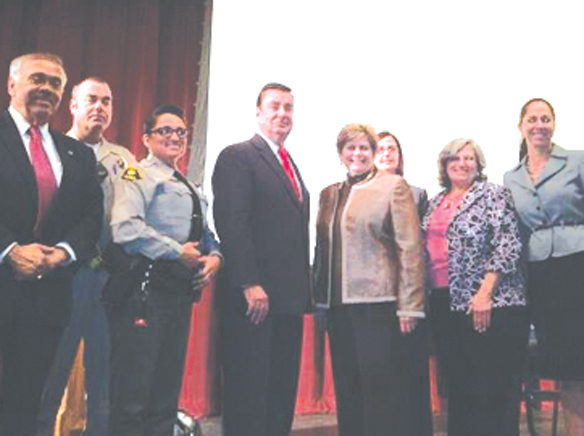On Thursday, San Diego County District Attorney Bonnie Dumanis, state Sen. Joel Anderson and a panel of law enforcement representatives from East County sat before a public audience at West Hills High School to discuss the dangers the youth community faces everyday. The meeting ended with a Q&A session that involved various topics of concern to local communities.
On Thursday, San Diego County District Attorney Bonnie Dumanis, state Sen. Joel Anderson and a panel of law enforcement representatives from East County sat before a public audience at West Hills High School to discuss the dangers the youth community faces everyday. The meeting ended with a Q&A session that involved various topics of concern to local communities.
“We wait until something horrible happens and then we make a law,” said Anderson, setting a tone of prevention for the panelists. “Let’s avoid jeopardy from the very beginning.”
This led into informative presentations by Danielle Benjamin from the Deputy Sheriff’s Dept., Kevin Pearlstein from the California Highway Patrol, and Dana Stevens from CASA (Communities Against Substance Abuse).
“Be extremely nosy,” said Benjamin on the issue of drug use. “Middle school is the average age of experimentation for drugs, cigarettes, and alcohol for children. While many tips given would seem like common sense to parents, children by nature will be resistant, and some signs of trouble are easy to miss.”
Whether it is monitoring social media accounts and online activity (such as Computer Cop, software that helps parents monitor their kid’s web surfing habits), looking through backpacks and keeping tabs on friends, involvement is key in prevention. Recognizing the red flags, changes in sleeping patterns, grades and health can be the difference between life and death, she said.
Drug and alcohol use are also a factor car accidents, a leading cause of death among children.
“Ninety percent of the time speeding is a factor, forty percent of the time DUI is a factor, and in half of every fatality, seat belts have not been worn properly,” said Pearlstein.
Technology is another danger to young drivers (who are more likely to die in an accident their first year of driving than any other time in their lives). Talking/texting this past year surpassed DUI as the leading cause of death among 15-19 year olds in crashes.
The phone that can lead to crashes is also a tool for bullies, via the social media and texting.
“Seventy-seven percent of students report verbal bullying mostly through Facebook, Instagram, and phones,” said Stevens. “Young bullies are more likely to engage in criminal behavior as adults.”
She continued with a screen presentation of how to handle the bullying that is seemingly inevitable. Encouraging victims and witnesses to walk away is the best tactic, not to give the bully an audience, Stevens said. When walking away does not work, parents should contact the school, and foremost, “be a model of non-violent behavior.”
When involvement, awareness, and avoidance fail, District Attorney Lisa Weinreb and Lisa Sawin, probation director, spoke about what happens after young people become involved in illegal activities. Juvenile diversion, intervention, rehabilitation and avoiding recidivism are their jobs. Their mission, they said, is “to protect community safety, reduce crime through offender accountability and rehabilitation,” and they do have success, more often when families of the offender participate. The punitive process can begin with something simple as a low-level offender signing a contract, while higher-risk or repeat offenders are more likely to have cases file against them. The criteria and plan for low-level, high-risk offenders and every kind of youth crime in between can be matched with the various programs the probation department has. Breaking Cycles program, camps, and the San Diego Regional Resiliency program.
“Change is the goal,” said Sawin. “Sanctions alone don’t change behavior.”
One panelist represented the Probation Department. Gang suppression, juvenile sex offenders, drug court, Community Assessment Team, Teen Watch (monitoring girls on probation with a drug history who are pregnant), and residential treatment centers all fall under probation.
When the panelists concluded, Public Affairs Officer Jesse Navarro read questions submitted by the audience, with panelists responding. Safety was undeniably the primary concern of East County citizens. Panelists spent nearly two hours discussing the strategies to curtail crime, yet the questions asked reflected doubt over whether the legal system can adapt as quickly as crime evolves.
“What is the city doing about human trafficking?” was one of the first questions asked, with the answer reassuring (sex crimes divisions are not limited to just one branch or office) to terrifying (rival gangs unite to recruit girls from local high schools by offering money and drugs in exchange for prostitution). Another question brought up the seeming frequency in which teachers are engaging in sexual activity with students. Anderson backed up a representative from the Santee School District when he said that “local districts are doing the best they can,” with the laws in place. Background checks done on staff, often repeated, and any suspicious behavior is simply not tolerated.
Discontent with certain laws in place and their effectiveness was evident among audience members as well as the people charged with enforcing them. There were responses given by panelists, including Anderson who had modest attempts to disguise disapproval.
“It’s the law until we change it,” was the answer given about the transgender bathrooms in schools bill signed into law by Governor Jerry Brown, as well as a question about mandating seat belts on school buses (many of which do not have restraining belts for children). Anderson encouraged to the audience to learn how their representatives are voting on important issues, because the system does not always work as best it should. “If people knew how they’re reps were voting, they’d be outraged,” he said.
Some answers were easy, some not so easy. Dumanis asked one audience member to discuss his issue with her after the meeting—ex offenders and other criminals living in close proximity to one another, if not in the same location, what can be done to change it, and how people in the effected neighborhoods can protect themselves and their families.
The final words of the meeting, the messages that the law wanted to drive home were repeated and reiterated; educate yourself, trust your gut instinct, be alert, and be safe. Grief can be spared and crime can be pushed back, and everything counts.














